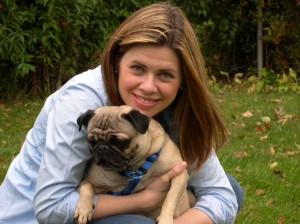Creature Feature
Bang! Crash! The Lightning Flashed…
By Stephanie Karpf, DVM
The hot months of summer are upon us, and for residents of South Florida, that means thunderstorms. Lots of thunderstorms! We also have the 4th of July to celebrate, and for many people this involves setting off obnoxiously loud fireworks. For many of our four-legged friends, these months are not fun.
Noise sensitivities, such as those to thunder and fireworks, are a fairly common problem in dogs. Some breeds, such as collies and other herding breeds, can be more likely to have this problem than others. However, I have seen this issue surface in dogs of just about every size and variety. Dogs that show anxiety or fear to thunder can have a large range of symptoms, including pacing, freezing in place, trembling, destruction of things in the home, hypersalivation, escape attempts, urinating or defecating in the house, crying, whining, barking, licking or self-mutilation, hiding, panting, diarrhea and vomiting. If your dog has this problem, it can be heart-breaking to see them get so “stressed out” by an event that you know is not going to harm them. It is important to remember that they are not “dumb” or “crazy” because of this irrational fear. Dogs with this type of phobia or sensitivity often have no control over their reactions to these noises.
There are some things that you can do to help your dog, if they have this issue. The first is to create a “safe place” for your dog. This should be somewhere that is preferably dark and quiet. For dogs that willingly go into a crate, this can be a perfect place. It is best to use a crate made out of plastic, so that it is naturally dark inside. Or alternatively, you could throw a blanket over a wire crate to darken it. The door does not need to be closed on the dog, but can be if the dog seems to calm down more with the door closed. If your dog is not one that will agree to being crated, then the safe place should be a room that has no windows, and can be darkened. It is also best to close the blinds and shades on windows and doors during storms or fireworks displays. Many dogs do react to the light from lightening or fireworks, as they have made an association between the flashing lights and the noise that they are sensitive to.
Another step that can be taken is to play music during the storm. The music that humans find most calming—classical music with slow tempos and simple composition—is also the most calming to dogs. Playing this just loud enough to help drown out some of the thunder noise, can help calm a dog during a storm. Some dogs can even be taught to wear ear plugs, specially made for canine ears.
Pheromones, which are chemical mediators produced by animals to communicate with one another, can be very useful in treating this problem. One that is commonly used in behavioral therapy for dogs is called Dog Appeasing Pheromone (DAP). It comes as a diffuser, spray or collar. For dogs that have this anxiety issue, wearing a DAP collar or simply wearing a bandana that has been sprayed with this pheromone, can be very helpful.
For many dogs, a change in their diet, to one of lower protein and higher carbohydrates can be very helpful. Your veterinarian can prescribe a diet for your dog that meets their nutritional requirements while enhancing their ability to cope with this stress.
Many dogs that suffer from severe storm phobia, often need medication for this problem. Your veterinarian can prescribe short-acting medications to immediately reduce anxiety and panic, that only need to be given when an event is happening (or ideally, given at least one hour before the onset of the event). This is best for 4th of July, as it is easier to anticipate that this noise is actually going to occur at a given time. For dogs that have thunder phobia as well, there are medications that are given more chronically, over the course of months to help control these symptoms. If you think your dog would benefit from pharmaceutical therapy, you should see your veterinarian about this.
Behavior modification programs that involve desensitization and counter conditioning to the noises that elicit these types of fear and anxiety responses, is very beneficial. This is usually done using sound recordings. Your veterinarian or veterinary behaviorist can devise a protocol for you to work on with your dog, to help reduce their level of anxiety response. This type of program takes time and effort, but it is often very crucial in helping a dog overcome this fear.
Although this problem can be very frustrating, the most important thing to remember when dealing with a dog with storm phobia….is that they can’t help it! You should never punish a dog for showing anxious behavior during a thunderstorm or fireworks event. It is also best not to comfort them with a lot of soothing talk and petting and attention, as this often just reinforces their fear and anxiety. It is best to simply try to distract them with other activities, like fetch or obedience training skills, while modifying their environment as described above to drown out the sound. With appropriate treatment, your dog can be made a lot more comfortable during these “scary” events.
Dr. Karpf is the co-owner of The Visiting Vet, a housecall service for dogs and cats serving Palm Beach County. For an appointment, please call 561-252-8874.

